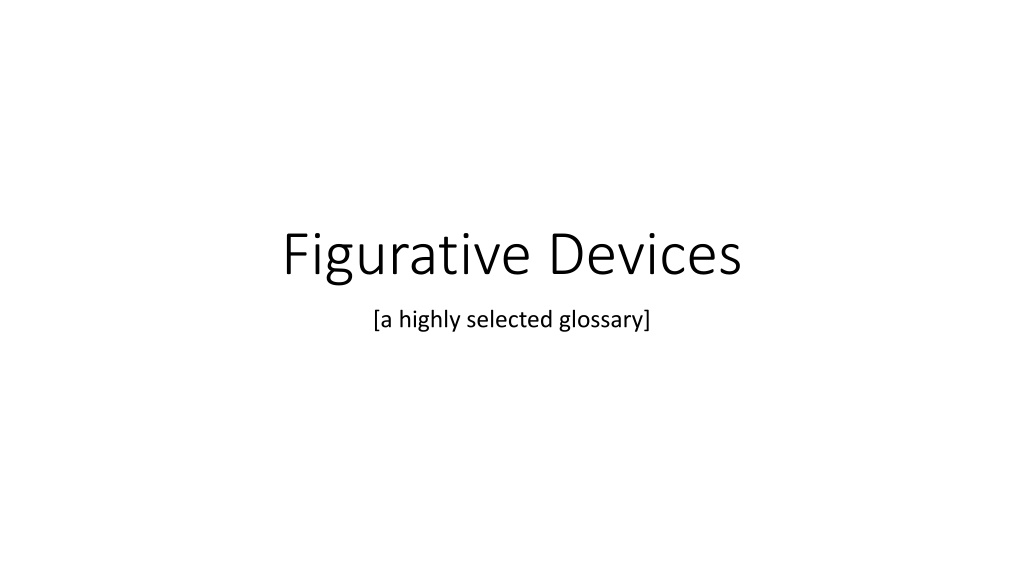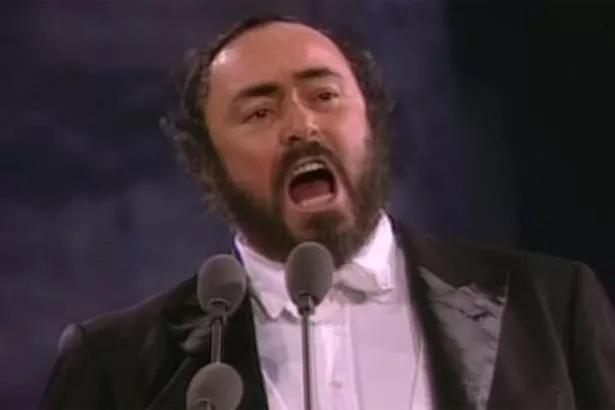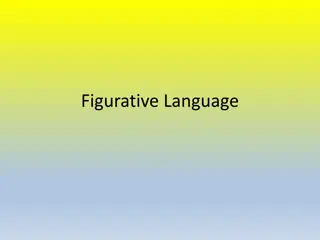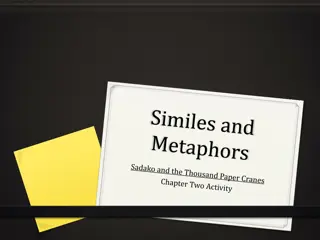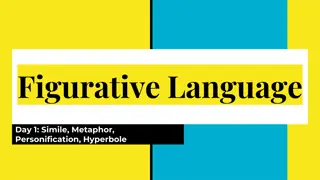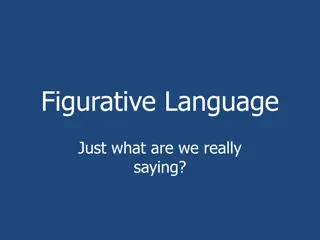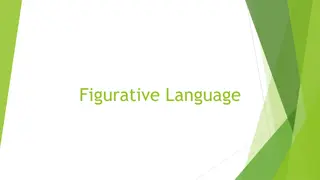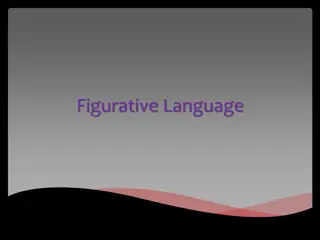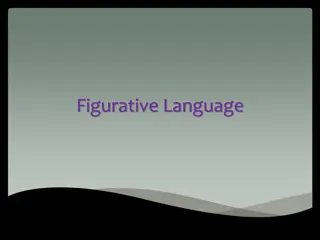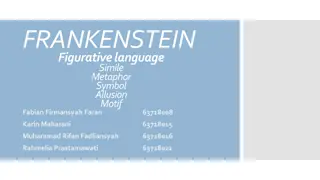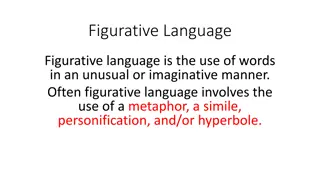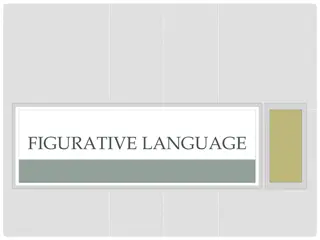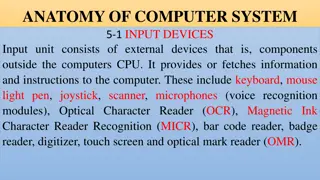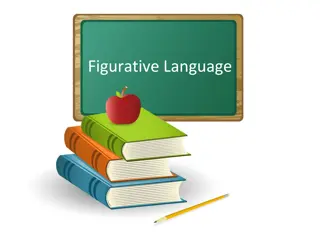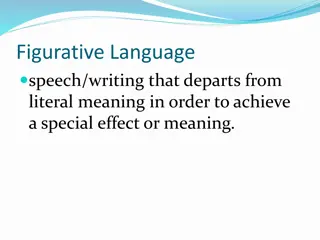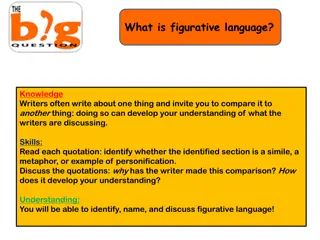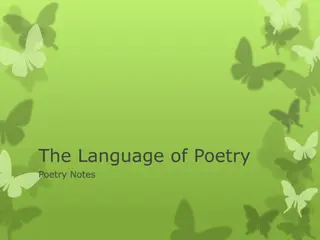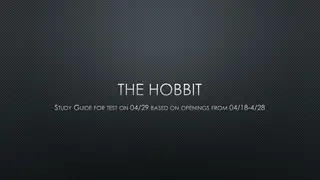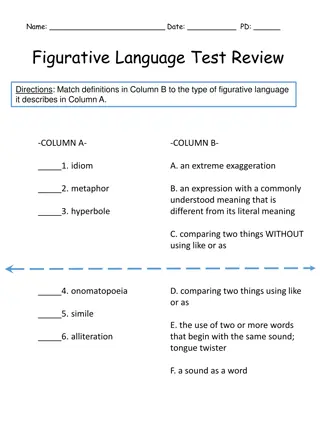Figurative Devices
This glossary delves into various figurative devices used in literature, such as metaphor, simile, symbolism, and more. Explore the nuances of language in conveying meaning through intricate comparisons and symbolic representations. Enhance your literary analysis skills with this detailed guide.
Download Presentation

Please find below an Image/Link to download the presentation.
The content on the website is provided AS IS for your information and personal use only. It may not be sold, licensed, or shared on other websites without obtaining consent from the author.If you encounter any issues during the download, it is possible that the publisher has removed the file from their server.
You are allowed to download the files provided on this website for personal or commercial use, subject to the condition that they are used lawfully. All files are the property of their respective owners.
The content on the website is provided AS IS for your information and personal use only. It may not be sold, licensed, or shared on other websites without obtaining consent from the author.
E N D
Presentation Transcript
Figurative Devices [a highly selected glossary]
Figurative Language Tenor and Vehicle Describing thing A by means of thing B. A is the tenor, the core idea being conveyed. B is the vehicle, the device that conveys the idea.
Metaphor Linking Disparate Things Metaphor Describing A (the tenor) as if it were B (the vehicle). Conceit Intricate or far-fetched extended metaphor (esp. in Renaissance literature). Simile Explicit comparison of A and B, often with like or as. Epic Simile Longer simile comparing actions, like a mini-story. Common template is: As when [B happens]. . . so did [A happen].
Epic Simile Example . . . as when two black clouds With heaven s artillery fraught, come rattling on Over the Caspian, then stand front to front Hovering a space, till winds the signal blow To join their dark encounter in mid-air: So frowned the mighty combatants, that hell Grew darker at their frown . . . John Milton, Paradise Lost 2.714-720 (Satan confronts Death)
Symbolism: Making the Abstract Concrete Symbol concrete object representing an abstract or moral idea. Personification kind of metaphor in which human qualities are attributed to anything that is not a person (objects, ideas, etc.). Allegory narrative where characters and events have symbolic meanings, often personifying moral qualities or abstract ideas.
Metonymy: Substituting Related Things Metonymy Referring to A (the tenor) by means of an associated term, B (the vehicle). The pen is mightier than the sword. [Pens are associated with writing, swords with war.] Synecdoche Subtype of metonymy where the part refers to the whole or vice versa. I have too many mouths to feed. [A mouth is a part of a person/child.]
Rhetorical Devices [a highly selected glossary]
Anaphora Repetition of a word/phrase at the beginning of several successive verses/clauses. We shall go on to the end, we shall fight in France, we shall fight on the seas and oceans, we shall fight with growing confidence and growing strength in the air, we shall defend our Island, whatever the cost may be, we shall fight on the beaches, we shall fight on the landing grounds, we shall fight in the fields and in the streets, we shall fight in the hills; we shall never surrender Winston Churchill, 1940
Antithesis Juxtaposition of contrasting ideas in a balanced, parallel structure. Better to reign in hell, than serve in heaven John Milton, Paradise Lost 1.263
Apostrophe Direct address to an absent, imaginary, or personified entity. O happy dagger! / This is thy sheath Shakespeare, Romeo and Juliet 5.3.169-170
B A Chiasmus A B Repetition of a structure in reversed order, i.e. in an ABBA pattern. From the crisscross shape of the Greek letter chi ( , ). The mind is its own place, and in itself Can make a heaven of hell, a hell of heaven A B B A John Milton, Paradise Lost 1.254-255
Hyperbole Extravagant exaggeration used for rhetorical effect. An hundred years should go to praise Thine eyes, and on thy forehead gaze; Two hundred to adore each breast, But thirty thousand to the rest; Andrew Marvell, To His Coy Mistress 13-16
Understatement Opposite of hyperbole. Restrained or minimizing language used for rhetorical effect. My mistress eyes are nothing like the sun; / Coral is far more red than her lips red Shakespeare, Sonnet 130 lines 1-2
Irony (and Sarcasm) Verbal Irony: The expression of one s meaning by using language that normally signifies the opposite (OED). Sarcasm: using language opposite to the intended meaning for humorous and/or cutting effect. Typically, using positive language while intending a negative meaning. Situational Irony: A state of affairs or an event that seems deliberately contrary to what was or might be expected; an outcome cruelly, humorously, or strangely at odds with assumptions or expectations (OED). Includes cosmic irony. Dramatic Irony: when the reader/audience knows something that the characters in a story do not. Includes tragic irony. You may encounter other types, e.g. Socratic irony.
Paradox An apparent contradiction that reveals a deeper truth. a grateful mind / By owing owes not but still pays, at once / Indebted and discharged. What burden then? Milton, Paradise Lost 4.55-57
Oxymoron A specific form of paradox: a word or phrase that tightly juxtaposes contradictory elements in order to express (or mock) an idea. O brawling love! O loving hate! O anything of nothing first create! O heavy lightness, serious vanity! Misshapen chaos of well-seeming forms! Feather of lead, bright smoke, cold fire, sick health! Still-waking sleep, that is not what it is! This love feel I, that feel no love in this. Shakespeare, Romeo and Juliet 1.1.175
Rhetorical Question Asking a question only to produce an effect or make a statement, rather than to elicit an answer or information (OED). Rhetorical questions typically have one correct answer or are designed to be unanswerable. The correct answer can be stated or unstated but either way is meant to be apparent. If you prick us, do we not bleed? If you tickle us, do we not laugh? If you poison us, do we not die? And if you wrong us, shall we not revenge? Shakespeare, Merchant of Venice 3.1.59-62
Logical Fallacies 1/4 Biased Language Using words which assume the validity of your argument. [e.g. the decision to call a paramilitary group terrorists or freedom fighters. ] Red Herring Bringing in irrelevant facts to create a desired emotional tone. How can you authorize this tax cut when murderers run loose in our streets? Ad Hominem Attacking the people who support a position, not the position. The problem with this proposal is that it was written by a bunch of corrupt politicians.
Logical Fallacies 2/4 Transfer Associating a prestigious name with one s own argument. Opposite of ad hominem. The president herself supports this plan! Bandwagon Appeal Claiming that an opinion must be valid because it is popular. This bill is a good idea because the American people overwhelmingly support it. Begging the Question/Circular Reasoning Assuming what you seek to prove. Faculty shouldn t go to student council meetings because the meetings should be for students only.
Logical Fallacies 3/4 Either/Or Reasoning Creating a false dichotomy. Either we legalize drugs, or this country will belong to the gangs within five years. Faulty Generalization Making a claim which is larger than your evidence warrants. In a poll, 60% of New Yorkers voted for Democrats. Therefore, most Americans are liberal. This law would be expensive and difficult to enforce. Therefore, there is no reason to support it. Throughout history, humans have tried to deal with cultural differences.
Logical Fallacies 4/4 Post Hoc Explanation Assuming that correlation implies causality. Since women have been allowed to vote, crime has increased. Therefore, only men should vote. Slippery Slope Falsely claiming that one event causes a particular chain of inevitable events. If we let them legalize drugs, they ll legalize murder next, and then society will collapse. Straw Man Distorting or simplifying opposing arguments so they are easier to refute. Basically, my opponent hates America.
Key Terms for Analyzing Poetry
Structural vs. Incidental Techniques Structural recurring in a fixed pattern, required by the formal rules of the poem. Incidental not required or restricted in use, usually reinforcing a specific point in the poem. How do the poem s incidental elements interact with its structural ones? Does the poem use the same technique both structurally and incidentally? (Most of the terms listed below could be used in either way). Does the poem use structural techniques not listed here? If so, what, how, and why?
Rhythmic Patterns Meter formal template of stressed and unstressed syllables. Rhythm the poem s actual accents when read aloud. Caesura a pause within a line. Enjambment when a grammatical unit runs across a line break. End-stopping opposite of enjambment. What purposes might the choice of metrical scheme serve? How do the actual accents and pauses conform to the meter and line breaks? What effects does the conformity or lack thereof produce? How does it support the meaning of the poem?
Sound Repetition Rhyme may occur at the ends of nearby lines or within the same line. Stanza a block of lines unified by a shared rhyme scheme. Assonance repetition of a vowel sound in two or more nearby words. Alliteration repetition of a consonant at the beginning of nearby words. Are the repetitions required by the poem s form (structural) or not (incidental)? Does the poem repeat classes of similar consonants? Some examples: hard (k, t, etc.), soft (f, m), liquid (l, r), sibilant (s, x). Or similar vowels? How does the overall rhyme scheme interlock or separate sections/stanzas of the poem? How do the repetitions of sounds work to create aural effects in specific lines? Do the stanzas coincide with rhetorical divisions in the poem?
Structures of Meaning Syntax sentence structure and word order (e.g. position of subject, verb, clauses, etc.). Figurative Language conceit, simile, metaphor, personification, allegory, symbolism . . . Verse Paragraph a block of lines set apart for reasons other than rhyme. Rhetorical Structure the stages in the ideas or argumentative logic of the poem. Do the sentences have an unusual word order? Are they short or long? Smooth or broken up? What ambiguities, separations, and connections do the sentences and grammar create? What figurative comparisons does the poem use and how do they produce meaning? Is there a logic to the progression from image to image? Are the metaphors/similes counterintuitive? What kinds of qualities are cited as reasons for drawing the comparison? What is the premise that drives the poem? What are the stages in the poem s development of its ideas? Are there shifts or even reversals in the poet s ostensible position? What implicit ideas or assumptions does the poem communicate, and how does it do so?
Meter in English Meter = Patterns of accented and unaccented syllables. Accentual verse regulates # of accents per line. [e.g. Beowulf] Syllabic verse regulates # of syllables per line. [e.g. haiku] Accentual-syllabic verse regulates both. [ normal English meter] Non-metrical poetry = free verse if in lines, prose poetry if not.
Accentual-Syllabic Meter Lines are composed of a certain number of feet. Foot = a 2-3 syllable unit with a particular accent pattern. Iamb = foot that sounds like da DUM. Pentameter = 5 feet per line. Iambic pentameter = da DUM da DUM da DUM da DUM da DUM. BUT the actual rhythm often deviates from the meter. oSyllables can be added or subtracted. oAccents can be added, subtracted, or moved. o To be, or not to be, that is the question.
Common Feet ( / = accented, u = unaccented) Foot Accent Direction Example Can it be used structurally? u / iamb Rising attack Yes most common foot u u / anapest Rising interfere Yes can also be mixed with iambs / u trochee Falling cattle Yes often catalectic / u u dactyl Falling monitor Yes often catalectic / / spondee Level choppedwood Maybe kind of? u u pyrrhic Level in a No its very existence is debatable
Modified Feet ( / = accented, u = unaccented) [you can add or subtract a syllable from the beginning or end of lines] Foot Accent Direction Example Can only be used at feminine iamb feminine anapest catalectic foot acephalic foot u / u Rising the question End of a rising line u u / u Rising interference End of a rising line / End of a falling line (trochees or dactyls) Beginning of a rising line Falling cows / Rising cows
Line Lengths (how many feet per line?) Name Feet Popularity Example monometer dimeter trimeter tetrameter pentameter 1 2 3 4 5 Very rare Rare Fairly common Common Most common With thee Drop, drop, drop, drop, O Earth O Earth return! My swirling wants. Your frozen lips. The world is too much with us; late and soon, hexameter fourteener octameter 6 7 8 Uncommon Rare Very rare Loving in truth, and fain in verse my love to show, I went into a public- ouse to get a pint o beer, I am the very model of a modern Major-General
Scansion Definitions Scansion= any method of notating a poem s meter and/or rhythm. Simpler methods just mark accented and unaccented syllables. We will use a method that separately marks meter and rhythm. Meter = the formal template or expected pattern of accents. Rhythm = the actual accents when read properly. Substitution = when the rhythm deviates from the meter.
Scansion Tips You can start with meter or rhythm. Meter is the poem s overall groove hear it in the whole poem; don t try to guess it from a single line. Mark a syllable accented only if it is more stressed than the syllables right next to it. Not all accented syllables are equally heavy. Sometimes there is only one right scansion; sometimes it s subjective. Polysyllabic words usually have a required accent pattern. Fill those in first! 1-syllable words are more open to interpretation. More important words are usually more likely to be accented. If rhythm and meter don t mostly match up, the scansion is wrong.
Renaissance Forms Blank verse = unrhymed iambic pentameter (common in plays of the period and used in Milton s Paradise Lost). Sonnet = 14 line poem with several possible rhyme schemes and a turn of thought partway through. Varieties include: 1. Italian/Petrarchan: Octave (8 lines) + Sestet (6 lines) E.g. ABBAABBA CDECDE (but many variants) 2. English/Shakespearean: 3 Quatrains (4 lines each) + Couplet (2 lines) E.g. ABAB CDCD EFEF GG (but many variants)
Reading Renaissance Verse Renaissance poetry uses long sentences. Enjambment (syntax flowing over a line break) is common. Read through line breaks without stopping, unless there is punctuation. TRANSLATE CLAUSE BY CLAUSE, NOT LINE BY LINE. To be, or not to be, that is the question, Whether 'tis nobler in the mind to suffer The slings and arrows of outrageous fortune, Or to take arms against a sea of troubles, And by opposing end them? To die: to sleep; No more; and by a sleep to say we end The heart-ache and the thousand natural shocks That flesh is heir to, 'tis a consummation Devoutly to be wish'd.
